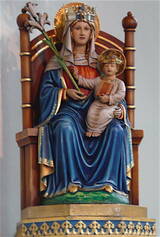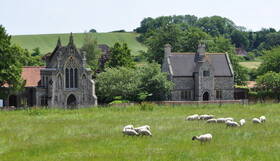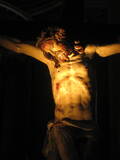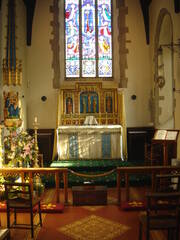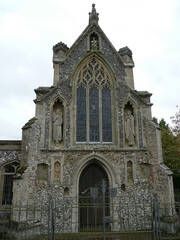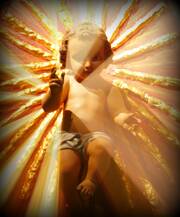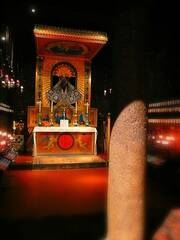Walsingham, England
The National Shrine of Our Lady in England
Feast Day of Our Lady of Walsingham - 24th September
Main Marian pilgrim destination in Europe up until the Reformation.
During this extraordinary time when many around the world are unable to attend Holy Mass & are in situations of 'self-isolation', more great resources of prayer are being shared on the internet. Amongst them, Ruth from the Totus2us is especially recommending the livestream from Walsingham: Daily Mass at midday (UK time) plus adoration of the Holy Eucharist, praying of the rosary & the Divine Mercy chaplet in the Shrine are all being streamed live 24 hours a day now - see livestream below or click here to watch on the Shrine's website.
3 2us on Our Lady of Walsingham by Father Ed Tomlinson ![]()
"The year is 1061 and, under a Catholic banner, England is known as Our Lady's dowry and its flourishing like never before. This was a great golden era, a time of renewal: cathedrals are built, churches are erected and they're going to define the landscape for so many different generations. Catholic devotion suits the English people and it leads to a great cultural flowering, producing in my opinion the greatest art, music and architecture that this land has ever seen. And in a tiny Norfolk village we find a noblewoman, Richeldis de Faverches, deep in prayer. To her amazement, the Blessed Virgin appears to her in a vision 3 times, instructing Richeldis to build a replica of the Holy House of Nazareth. Richeldis undertakes this work with obedience and soon a spring of living water is unearthed. Once built, the priory shrine of Our Lady of Walsingham became the beating heart of Catholic England. From all over Europe people flocked, to be healed, to pray, to receive the sacraments, to give devotion to the Lord. Peasants and kings were equal here, in this place of profound grace, miracle and favour."
Anouska, from London ![]()
"My latest experience of Our Lady is when I went to a retreat in Walsingham and, while a lady was praying with me, she saw a vision of Our Lady giving me a sceptre and a veil above my head, and I immediately felt her protection. When I feel alone, I relive that experience and then I remember she is with me and that she is a mother like no other and that all my prayers will be directed to her son."
Paul, from England, was a pilgrim to Walsingham ![]()
"It was a time of discovering who Mary is for me in my life at this time because sometimes my relationship with Mary takes a back seat. I found through the 3 days I was there to really enjoy a love for Mary again, to discover the rosary in more depth, to understand her ideas for the world and what her example can be for me today and for the rest of humanity."
Collette, from England, ![]()
"Earlier this summer I was in Walsingham and I went and made a life confession with a priest there. It was pretty life changing. I opened my heart to God, something I'd never done before, I'd been to confession many times but I'd never been honest with God and never been honest with myself I suppose. I just really put it in the Lord's hands and opened my heart to Him, and the love and mercy that I experienced through his vehicle, through his instrument the priest, just left me absolutely speechless."
Every summer, Walsingham is home to the New Dawn conference (early August) & the Youth 2000 festival (end of August bank holiday week-end).
The Story of Walsingham
by Erin-Thérèse
In 1061, Our Lady heard the prayer of a Saxon noblewoman, Richeldis de Faverches, that she might undertake some special work for the Blessed Virgin. In return, Richeldis was presented with a vision of the 'Holy House', the house in Nazareth where the Annunciation took place. Our Lady asked Richeldis to build an exact replica of that house in Walsingham, a small village in Norfolk, England.
After the vision was repeated three times, the house was miraculously constructed one night with materials provided by Richeldis, while Richeldis herself kept a vigil of prayer. ‘England’s Nazareth’ was born, and nearly 1,000 years later, pilgrims still come in large numbers to the shrine of Our Lady of Walsingham.
Walsingham was one of the most popular sites of medieval pilgrimage, with both peasants and royalty flocking faithfully to the Marian shrine. However, Walsingham suffered badly during the Reformation in England, when King Henry VIII, himself formerly a pilgrim to this honoured shrine, gave orders for the shrine to be torn down and the neighbouring priory dissolved. The famous statue of Our Lady of Walsingham, housed in the Holy House since its original construction, was burnt under the accusation of idolatry.
At the turn of the 20th century, a Roman Catholic pilgrimage to the neighbouring Slipper Chapel sparked off an eventual restoration of the Walsingham shrine. Fr Patten, the Anglican Vicar of Walsingham, helped to renew Anglican interest in England’s great Marian shrine and was a pivotal figure in its restoration. A new statue of Our Lady of Walsingham, a replica of the medieval original, was enshrined in the rebuilt Holy House.
Today, Mary’s shrine at Walsingham is aglow with candles lit by Christian pilgrims of various denominations, with both Catholic masses and Anglican services being celebrated in the Holy House. The Slipper Chapel is the center of Catholic prayer and worship in Walsingham, and notably served as one of the sites for the veneration of the relics of St Thérèse of Lisieux in October 2009. The sacraments are again alive at Walsingham, with Eucharistic adoration and confession being revived by the Youth 2000 movement.
Walsingham's intense spiritual atmosphere has to be personally experienced; it is a sign of Mary’s enduring queenship in England, of the healing of our Christian past, and the hope we have for the reconversion of England. Pilgrims can pray ‘Hail Mary’ within walls just like those that echoed to the Angel Gabriel’s own ‘Ave Maria.’
The feast of Our Lady of Walsingham is celebrated on September 24th in England. It was formerly celebrated on March 25th, the feast of the Annunciation.
Several English kings visited the Shrine in Walsingham, including Henry III (1231 or 1241), Edward I (1289 and 1296), Edward II in 1315, Edward III in 1361, Henry VI in 1455, Henry VII in 1487 and finally Henry VIII, who was later responsible for its destruction when the shrine and abbey perished in the Dissolution of the Monasteries.
In 1537 while the last Prior, Richard Vowell, was paying obsequious respect to Thomas Cromwell, the Sub-Prior, Nicholas Milcham, was charged with conspiring to rebel against the suppression of the lesser monasteries and, on flimsy evidence, was convicted of high treason and hanged outside the Priory walls. Eleven people in all, including two lay choristers who had been instrumental in organising the revolt were hanged, drawn and quartered. What they feared would happen came the following year. In the July Prior Vowell assented to the destruction of Walsingham Priory and assisted the king's commissioners in the removal of the figure of Our Lady and many of the gold and silver ornaments and in the general spoliation of the shrine. For his ready compliance the Prior received a pension of 100 pounds a year, a large sum in those days, while 15 of the canons received pensions varying from four to six pounds. With the shrine dismantled and the priory destroyed, the site was sold by order of Henry VIII to Thomas Sidney for 90 pounds and a private mansion was subsequently erected on the spot. Gold and silver from the shrine was taken to London along with the statue of Mary and John (Jesus) which was later burnt.

